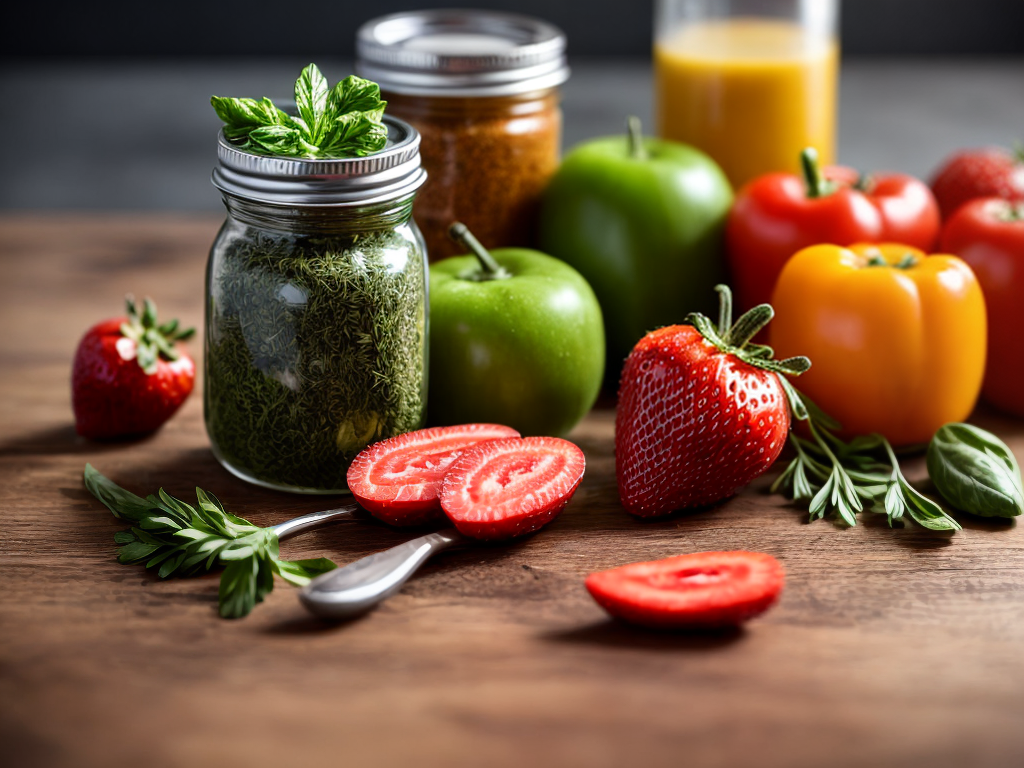
When it comes to cooking, one thing many people overlook is the importance of choosing quality ingredients. Did you know that not all ingredients are created equal? From fresh produce to meat and seafood, there are factors to consider when selecting the best options for your meals. In this discussion, I will explore the world of food labels, the benefits of seasonal and local produce, the difference between organic and conventional options, and how to evaluate the quality of meat, seafood, dairy, and grains. Stay tuned to discover the secrets of choosing the best ingredients for your culinary creations.
Importance of Quality Ingredients
The importance of using quality ingredients cannot be overstated when it comes to creating a delicious and nutritious meal. Using fresh ingredients has numerous advantages that directly impact the taste of the final dish. Fresh ingredients retain their natural flavors and textures, enhancing the overall taste experience. They also tend to be more vibrant in color, making the meal visually appealing.
When it comes to taste, quality ingredients can elevate a dish from ordinary to extraordinary. Fresh fruits and vegetables, for example, are bursting with flavor and contribute to a vibrant and well-balanced taste profile. Similarly, using high-quality meats and seafood ensures a tender and succulent texture, making every bite a delight.
Moreover, quality ingredients are crucial for ensuring food safety. Fresh ingredients are less likely to harbor harmful bacteria or contaminants, reducing the risk of foodborne illnesses. By using fresh and quality ingredients, we can have peace of mind, knowing that we are providing our loved ones with safe and healthy meals.
Understanding Food Labels
Now let’s explore how to understand food labels for making informed choices when selecting ingredients. When it comes to ensuring the safety and quality of the food we consume, interpreting nutrition facts and decoding ingredient lists is crucial. Here are five key points to keep in mind when reading food labels:
-
Check serving size: Pay attention to the serving size listed on the label. This will help you accurately assess the nutritional content of the product you’re considering.
-
Evaluate calories: Look at the number of calories per serving. This information will aid in managing your calorie intake and maintaining a balanced diet.
-
Examine nutrient content: Take note of the nutrients listed on the label, such as fat, carbohydrates, protein, and vitamins. Understanding these values can help you make healthier choices.
-
Analyze ingredient lists: Read the ingredient list to identify any potential allergens or additives you may want to avoid. The order of ingredients can provide insight into their relative quantities.
-
Be cautious of misleading claims: Be aware of marketing buzzwords like “natural” or “low-fat.” Always verify the actual content of the product by thoroughly reading the nutrition facts and ingredient list.
Seasonal and Local Produce
When selecting ingredients, it is important to consider the benefits of seasonal and local produce. Eating seasonal produce not only supports sustainability practices but also offers numerous health benefits. Seasonal fruits and vegetables are harvested at their peak ripeness, ensuring optimal flavor and nutritional value. They are also less likely to be subjected to chemical treatments and preservatives, which can be harmful to our health. By choosing local produce, we reduce the carbon footprint associated with transportation and support our local farmers.
Eating seasonal and local produce promotes a healthier lifestyle. These fruits and vegetables are packed with essential vitamins, minerals, and antioxidants that are vital for our overall well-being. Additionally, consuming seasonal produce allows us to enjoy a varied and diverse diet throughout the year, providing our bodies with a wide range of nutrients.
When we support local farmers, we contribute to the sustainability of our communities and ecosystems. Local farmers often employ sustainable farming practices, such as crop rotation, natural pest control, and water conservation, which help preserve the environment and maintain the quality of our soil and water sources.
Organic Vs. Conventional Options
As we continue our exploration of choosing quality ingredients, let’s now examine the differences between organic and conventional options.
-
Organic farming: Organic farming emphasizes the use of natural methods to grow crops and raise livestock. It avoids the use of synthetic pesticides, genetically modified organisms (GMOs), and artificial additives.
-
Pesticide exposure: Conventional farming often involves the use of synthetic pesticides to control pests and increase crop yields. These chemicals can leave residues on the produce, which may pose health risks to consumers.
-
Health benefits: Organic options are believed to be healthier as they contain fewer pesticide residues and higher levels of certain nutrients. They also promote biodiversity and sustainable farming practices.
-
Environmental impact: Organic farming practices are designed to protect soil health, conserve water, and reduce pollution. By choosing organic options, you are supporting a more sustainable and eco-friendly approach to agriculture.
-
Cost considerations: Organic options tend to be more expensive due to the higher costs associated with organic farming practices. However, the benefits to your health and the environment may outweigh the higher price tag.
When it comes to choosing between organic and conventional options, it ultimately depends on your priorities. If you prioritize minimizing pesticide exposure and supporting sustainable farming practices, organic options may be the way to go. However, if cost is a major concern, conventional options might be more suitable for your budget.
Evaluating Meat and Seafood
To ensure you are choosing high-quality ingredients, it is important to evaluate the meat and seafood options available. When evaluating freshness, there are a few key factors to consider. First, check the sell-by or use-by date on the packaging. This will give you an idea of how long the product has been sitting on the shelf. Additionally, look for any signs of spoilage such as an off smell, slimy texture, or discoloration. These can be indications that the meat or seafood is past its prime.
In terms of sustainable sourcing, it is important to choose products that are responsibly harvested or raised. Look for labels such as “wild-caught” or “sustainably sourced” to ensure that the seafood you are buying is not contributing to overfishing or other environmental concerns. For meat, consider purchasing products that are organic, grass-fed, or free-range. These labels indicate that the animals were raised in more humane and sustainable conditions.
Navigating the Dairy Aisle
I find navigating the dairy aisle to be a breeze with a few helpful tips and tricks. When it comes to choosing quality ingredients, reading labels and comparing prices are essential. Here are some key things to keep in mind:
- Look for the words “organic” or “grass-fed” on dairy products. These labels indicate that the cows were raised without the use of antibiotics or hormones, resulting in a safer product for you and your family.
- Check the expiration dates. It’s crucial to select dairy products with a longer shelf life to ensure freshness and prevent spoilage.
- Compare prices per ounce. Sometimes, the larger container may seem more cost-effective, but calculating the price per ounce can reveal the better deal.
- Consider the fat content. Whether you prefer whole milk or low-fat options, it’s essential to choose what suits your dietary needs and preferences.
- Opt for dairy products with minimal additives. Artificial flavors, colors, and preservatives can negatively impact the quality and safety of the product.
Choosing Whole Grains
When it comes to choosing quality ingredients, one important aspect to consider is the inclusion of whole grains. Whole grains offer numerous benefits, such as providing essential nutrients and fiber. There are various types of whole grains available, including oats, quinoa, and brown rice, each with their own unique flavors and textures.
Benefits of Whole Grains
Choosing whole grains offers a plethora of benefits, including improved digestion, increased nutrient intake, and reduced risk of chronic diseases. Whole grains are rich in fiber, which aids in digestion and helps prevent constipation. They also contain essential vitamins and minerals, such as B vitamins, iron, and magnesium, that contribute to overall health and well-being. Additionally, whole grains have a lower glycemic index compared to refined grains, which means they provide a steady release of energy and help regulate blood sugar levels. Incorporating whole grains into your diet can also help lower the risk of heart disease, type 2 diabetes, and certain types of cancer. To fully enjoy the nutritional value of whole grains, it is important to choose cooking methods that retain their natural goodness, such as steaming, boiling, or baking.
Types of Whole Grains
To make informed choices when selecting whole grains, consider the various types available and their unique nutritional profiles. Whole grains come in many forms, including brown rice, quinoa, oats, barley, and whole wheat. Each type of grain has its own distinct flavor and texture, making it suitable for different cooking methods. Brown rice is great for stir-fries and pilafs, while quinoa is perfect for salads and grain bowls. Oats can be used in baking or enjoyed as a warm breakfast cereal. Barley is often used in soups and stews, adding a hearty and chewy texture. Whole wheat is commonly used in bread, pasta, and baked goods. These grains offer a range of nutritional benefits, such as fiber, vitamins, and minerals, making them an essential part of a healthy diet.
Avoiding Artificial Additives
I always prioritize selecting food products that are free from artificial additives. It’s important to be aware of the impact that these additives can have on our health and well-being. Here are five reasons why avoiding artificial additives is crucial:
- Health risks: Artificial additives have been linked to various health issues such as allergies, hyperactivity, and even cancer.
- Nutritional value: Artificial additives often provide little to no nutritional value, which means they contribute empty calories to our diet.
- Natural alternatives: By avoiding artificial additives, we can choose natural alternatives that are healthier and provide genuine nutritional benefits.
- Food transparency: Opting for products without artificial additives allows us to have a clearer understanding of what we are consuming, promoting transparency in the food industry.
- Safety concerns: Artificial additives are often created using chemicals that may have long-term effects on our health. By avoiding them, we can prioritize our safety and well-being.
Conclusion
Choosing quality ingredients is essential for ensuring the health and taste of your meals. By understanding food labels, opting for seasonal and local produce, and considering organic options, you can make informed choices. Evaluating meat and seafood sources, navigating the dairy aisle, and choosing whole grains are also important steps. Finally, avoiding artificial additives can further enhance the quality of your ingredients. With these guidelines in mind, you can confidently select ingredients that will contribute to delicious and nutritious meals.






